Various factors lead to tooth wear. They are destroyed. Both banal caries and all kinds of injuries lead to this. Some diseases also cause tooth decay. So what should we do? Fortunately, modern technologies and materials allow you to completely restore lost functions. In order to strengthen the damaged unit, crowns are placed on the teeth. How do they put it? What are they? Which ones to choose? You will find answers to these and other questions in this article.
What are crowns and bridges?
The structure that covers a completely destroyed tooth is called a crown. It is fixed using special cement. Its function is not only to strengthen and protect the jaw arch unit. Crowns can even change the shape of a tooth. But today the aesthetic aspect is very important for many patients.
A bridge is a structure that replaces missing teeth on the jaw arch. If the patient is missing at least one unit, then it can be restored through implantation. But this method has been used relatively recently in the post-Soviet space and is considered expensive. But prosthetics using bridge structures have been used for a long time. And this method is available to every patient. The cost of the service will depend on the materials used in the manufacture of the bridge. Next we will talk about what types of crowns are placed on teeth.
Kinds
Crowns are divided according to several principles.
The first is when products are differentiated depending on the purpose of the structure. They are supportive and restorative.
The second principle divides orthodontic products according to the type of material from which they are made (metal, non-metal, mixed).
Products are distinguished according to the principle of their design. There are full crowns that cover the entire tooth. There are also so-called half-crowns. These products do not cover the back of the jaw arch unit.
To carry out the splinting procedure, equatorial structures are made. This is a kind of strip that covers the tooth in a circle.
To restore severely damaged units, stump crowns are made on teeth. How do they put it? The doctor performs them so that the edges of the product deepen under the edge of the gums.
Also, in cases where the unit is significantly damaged, crowns with a pin are installed. This allows you to create additional support.
To select the height of the product directly on the tooth itself, telescopic structures were created.
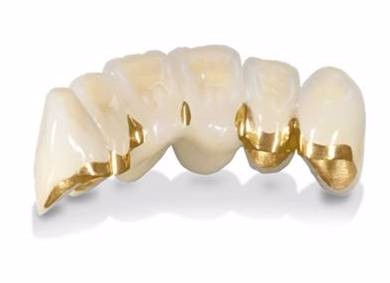
Installation process
So, what do you need to know if you are going to restore a unit with a crown? How are they placed on the teeth? Let's look at the whole process.
1. The most important stage is preparing teeth for prosthetics. If necessary, the dentist performs fillings, removal of tartar, and depulpation. Next, the tooth needs to be ground. Depending on the selected material for the structure, it will be removed upper layer a certain thickness (1.5-2 mm). If a nerve has not been removed from the unit, the doctor will use anesthesia during the dissection. It will allow all manipulations to be carried out without causing much discomfort to the patient.
2. When the grinding is completed, it is time to take impressions of the jaw. The specialist does this using plaster.
3. The impressions are handed over to the dental technician. And he is already making a crown.
4. Then the patient is invited to try on the design. The doctor marks the areas that need to be corrected.
5. After the crown is finally ready, the specialist places it on the ground tooth using special glue.
In cases where it is planned to install structures made of ceramics or zirconium dioxide, the specialist offers a plastic crown during manufacturing (the process may take several weeks). This way a person will be able to lead a full life.
Sometimes patients ask the question: “Is it possible to put a crown - the tooth is practically destroyed?” Today, technology makes it possible to restore any unit. If the condition of the root is satisfactory, the doctor places the crown on pins that serve as additional support. Or they use special inlays that imitate the lost part of the tooth.
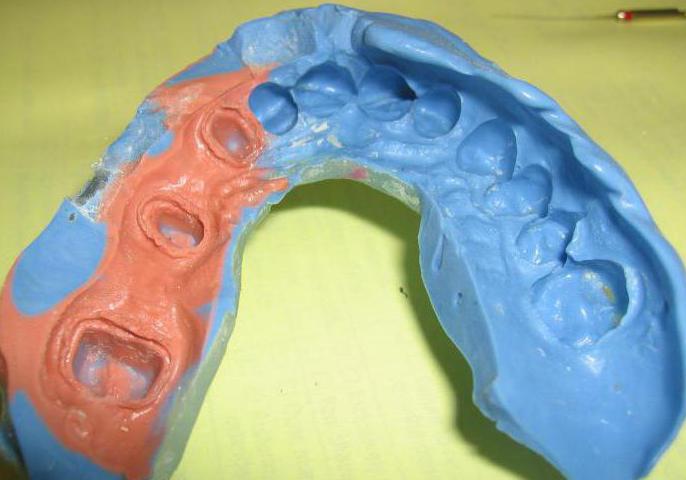
Solid metal crowns
Despite the fact that dentistry is developing very quickly today, orthopedists note that metal crowns are still in demand among patients. When the question arises, which crowns to put on chewing teeth, the doctor may recommend designs made from a gold alloy.
They are not suitable for the frontal area, as they will disrupt the aesthetics of the smile. But they can be installed on side units that are not visible. The advantage of the material is its relative softness. This allows for a perfect fit of the crown walls to the ground tooth. This factor also has a beneficial effect on the preservation of the enamel of neighboring units. Gold wears out at almost the same rate as enamel. This protects it from premature erasure. Well, the crown, made of metal, copes well with the load exerted when chewing food. Such products do not chip. They generally very rarely break.
Reviews from specialists and patients
The opinion of doctors here is ambiguous. Some believe that metal crowns will be in demand for a long time to come. Experts note that the designs have earned their popularity due to such qualities as durability and affordability.
Other experts argue that only modern materials and technologies for prosthetics should be used. Today, patients also have mixed opinions about metal crowns. Many people remove them to replace them with products that are the same color as their natural teeth.

Plastic products
Typically, such structures are made for temporary use. But they are also suitable for continuous use. Plastic crowns closely imitate natural teeth. They can be made quickly, which is quite convenient. They are usually placed on the frontal area of the jaw. They are not able to withstand heavy loads. Therefore, they are placed on the lateral areas only for a while while the permanent prosthesis is being made.
Reviews
Plastic crowns are different at an affordable price. This makes them accessible to all segments of the population. However, they have a number of disadvantages.
1. Change color over time.
2. Not strong enough.
3. They require more careful maintenance than other structures. This is due to the porous structure of the plastic. Pathogenic bacteria quickly accumulate in the material.
4. Plastic causes allergic reactions in some patients.
5. Short service life.
At the same time, experts note the advantages of the material. When a patient asks what kind of crowns to put on his front teeth so that it is inexpensive, the specialist will recommend plastic structures. If there are no contraindications and the patient is not allergic, they will fit perfectly into the smile. With proper care, crowns should last 5 years. And according to patient reviews, such structures can last much longer.
Ceramics
To achieve the similarity of crowns with natural teeth, they began to be made from porcelain and other ceramic materials. These products are highly aesthetic. The material has translucent properties. And this makes it possible to produce a structure that, even at close range, cannot be distinguished from the patient’s natural teeth.
However, ceramics also have their disadvantages. The material is inferior in strength to metal alloys. Therefore, when asked which crowns are placed on the front teeth, a specialist can recommend all-ceramic products. They will not spoil, and in some cases even significantly improve the aesthetics of the patient’s smile. In this case, the load during chewing is distributed in such a way that the frontal zones receive a “gentle regime”. Here ceramics can last up to 15 years at proper care.
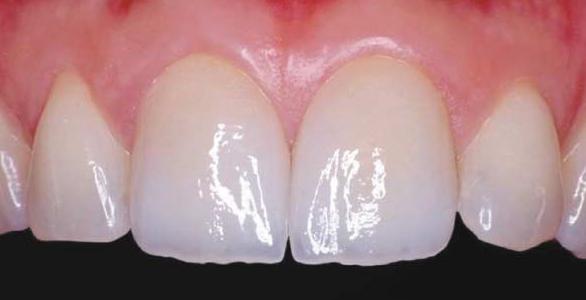
What crowns are best to put on teeth? Reviews about ceramics
Undoubtedly, the material is considered progressive in the field of dentistry. Pressed porcelain crowns look amazing. In this aspect, the opinion of specialists does not differ from the reviews of patients. The aesthetics of the smile are at their best. However, porcelain is inferior in strength to zirconium dioxide. Therefore, it is used only for the manufacture of single crowns for the front teeth. At the same time, the cost of the products is quite high. Not every patient can afford to install a ceramic crown.
Choosing a crown is not so easy, given their variety in manufacturing methods, materials and location of the teeth that need to be restored.
The main criterion that should be followed when choosing is the material.
For front teeth, metal-free ceramics (zirconium dioxide and porcelain), which are famous for their impeccable aesthetics, are better suited. And on the side teeth you can put crowns with a metal frame.
Of course, any option has its pros and cons. Read about it below.
Types of dental crowns by purpose
First of all, crowns are classified according to their purpose. They can be supportive and restorative.
Abutment crowns are used as an auxiliary element in prosthetics. If there are healthy “neighbors” on the sides of the lost tooth, crowns are fixed on them. This option is suitable for those who are afraid to install an implant or are allergic to the alloys from which they are made.
Restoring crowns, unlike abutment crowns, act as a full-fledged prosthesis that is attached to a single tooth. Their installation is indicated when the tooth is damaged by more than two-thirds.
By type of design
Another classification option is by type of construction:
- Full. Completely cover the supragingival part of the tooth.
- Stumps. They allow you to install a crown on a tooth from which only the roots remain.
- Equatorial. Cover the upper coronal part of the tooth only to the middle. Installed for splinting, increased abrasion.
- Telescopic. Needed for fixing clasp and plate prostheses in the absence of several teeth.
- Half-crowns. Cover only part of the chewing surface of the tooth. Used to support a prosthesis.
- Jackets. Installed on the front teeth in case of severe destruction, when filling is impossible.
- On the pin and pin tab. Used when the tooth is damaged by more than 50%. Installation takes 1-2 appointments.

Types of dental crowns and materials
There are many types of dental crowns. In their “pure” form, for example, metal or ceramic structures are now practically not installed.
Materials used to make crowns:
- metals and their alloys;
- plastic;
- ceramics;
- silicone;
- nylon;
- polyurethane.
Coated dentures and crowns made of a medical “composite” - an alloy of gold with copper, silver or platinum, an alloy of titanium with cobalt chromium or stainless steel - are being replaced by various combinations of metal: with ceramics, plastic or porcelain.
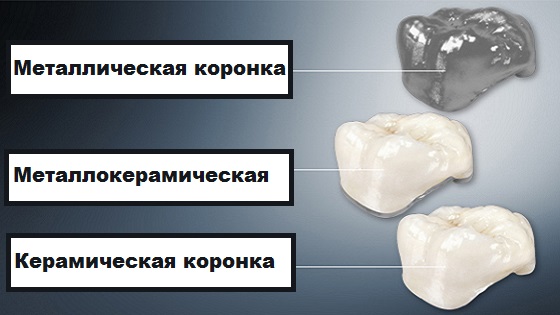
Crowns made of polymers
Composites are also suitable for making dental crowns - special polymers created by mixing various additives.
Clinical observations have shown that polymer crowns on pins made of silver-containing alloys are the safest for dental prosthetics for pregnant women.
Advantages of polymer crowns:
- Due to the instability of the marginal gingiva during this period, the installation of less expensive and non-allergenic structures is recommended.
- They are inferior to ceramic ones in terms of aesthetics, but in general they imitate real teeth well.
- Low cost of the prosthesis.
- Fast speed production - from 4 minutes. Can be installed on the day the impression is taken.
Which crown to choose for one tooth or even several? To answer this question you need to decide on your priorities.
What is more important to you, beauty or durability? Also worth considering anatomical features and the functions performed by the anterior and lateral teeth, about which we'll talk Further.
Which crown to put on chewing teeth
When choosing a combination of materials, the role that the tooth “plays” is not the least important.
As the name implies, chewing teeth are used primarily for chewing food, so when choosing a crown for such a tooth, you need to focus on its wear resistance.
IN this moment Unfortunately, in the arsenal of orthopedists there are no crowns that would equally combine high aesthetics and strength.
However, you shouldn't give up. The side teeth rarely come into the field of view of your interlocutor, since they are not included in the smile zone.
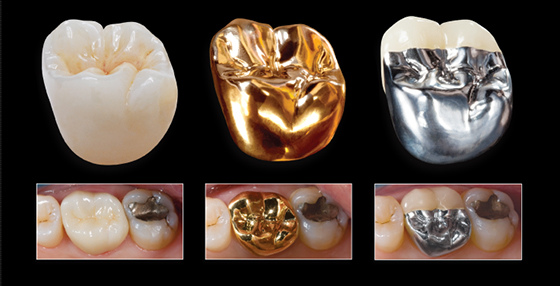
Stamped and cast metal.
The former are made from prepared sleeves, the latter are made from an individual cast, which allows for a greater fit of the crown. They are thick, and unlike stamped ones, they have no solders.
They have a long history of use due to their increased strength and lack of allergic reaction. In simple words, if some alloys are contraindicated for you, and you have sufficient funds, invest in a gold crown.
Metal ceramics.
The disadvantage of using them for prosthetics of lateral teeth is the insufficient strength of the ceramics, so chips and cracks appear on them more often than on others. Given their aesthetics, they are more indicated for restoring the anterior group of teeth.
The service life of such prostheses, even the most durable ones, is approximately 10 years, and it can be shortened by improper hygiene, rough food, and accidental mechanical damage, which sharply accelerate the wear of the base material.
In order to extend the life of the crown on a chewing tooth, try to eat too hard foods (nuts, candies, cozinaki, etc.) less often. This also applies to caring for real teeth.
Benefits of zirconium crowns
IN Lately orthopedists have found more reliable way prosthetics.
The variety of orthopedic prostheses has been replenished with designs made of zirconium, a material that has a number of advantages:
- hypoallergenic, antibacterial structure;
- low weight compared to metal ceramics;
- color identical to the natural shade of teeth;
- dental ergonomics – fits well to the gums;
- durability - 15-20 years, manufacturer's warranty - 5 years.
These are the best dental crowns available today.
Prosthetic options for anterior teeth
As a “budget” option for prosthetics of the front teeth, plastic structures can be used. They are unable to perform chewing functions even in combination with metal. Plastic quickly wears out under constant load, so this material is most often used for temporary prosthetics.
Soft dental crowns made of nylon or polyurethane are installed for people with weakened gums who are allergic to metal structures.
These are universal structures, so they are installed not only on the front teeth, but also used for complete prosthetics. Their service life is not long - 5-7 years.
Variations of metal with ceramic and porcelain as anterior dentures are most common. They successfully combine aesthetics and strength, sufficient to protect the internal dental tissues from the effects of food.
Photos “before” and “after” installation of crowns
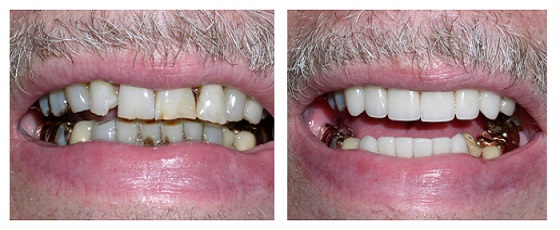
Prices for dental prostheses
The price list for dental prostheses is formed quite freely, so their cost can only be approximately indicated:
- full/partial nylon prosthesis – 48,000/44,000 rubles;
- metal-ceramic - from 16,000 rubles per unit;
- zirconium - from 26,000 rubles per unit.
Plastic and metal-plastic structures are usually not even offered in private clinics, due to their fragility.
The choice of options for prosthetics is wide enough to find one that suits you in all respects. To prevent trips to the dentist from becoming regular, you need to contact experienced specialists who have at their disposal not only a comfortable office, but also modern professional equipment.
Over time, the need for prosthetics appears in the life of almost every person. This may be due to both age-related changes and mechanical and pathological damage integrity bone tissue teeth.
Content:
Basic concepts and classification of crowns used for chewing teeth
In modern dentistry during treatment pathological processes in bone tissue, as a last resort, they resort to removing the damaged tooth. But, if liquidation was inevitable, after complete healing of the wound, it is necessary to address the issue of dental prosthetics. This will avoid displacement and curvature of the dentition.
Orthodontic onlays, which cover the part of the tooth protruding from the periodontium, can help eliminate this. Dental crowns are also used for defects that cannot be cured by invasive treatment. The shape of the prosthesis model should be similar anatomical structure tooth, providing comfortable wearing, especially when chewing.
Crown classification:
- By time of use: temporary and permanent.
- Intended use: restorative and supportive.
- By type of design: full, equatorial, stump, half-crown, telescopic, with a pin, fenestrated, jacket.
- By type of raw material for production: metal, non-metal and combined.
Types of prostheses depending on the material of manufacture:
- Metal - used to cover teeth that are subject to severe abrasion. Such crowns are very wear-resistant, which allows them to be used for 10-15 years. They can be made from noble and base metals. The most common products are made of nickel, gold and stainless medical steel. Another important point is the fact that to install this structure, the tooth is not sharpened much, and the cost of such dental prosthetics differs significantly from other methods.
- Non-metallic are divided into: metal-ceramics - a very durable structure, which consists of a metal frame covered with a special ceramic lining and plastic - which has proven itself not with best side. When preparing a tooth, such prosthetics cause severe damage and are an expensive dental service.
- Combined ones are used when there is a need for restoration, such as chewing teeth, and those that come into view when smiling. In this case, durable metal crowns are placed on the chewing teeth, and metal-ceramics are placed on the front teeth. This method will significantly save financial costs.
![]()
In modern dentistry there are many various types crowns Therefore, if necessary, we recommend contacting a highly qualified prosthetist who will help you choose the most suitable option for you, making your smile healthy and beautiful.
How to choose the right dental crowns for chewing teeth: manufacturing and installation
The standard, fully developed dentition of any person includes chewing teeth, which bear the maximum load when chewing food. So, if the first symptoms of the development of pathological processes appear in them, you should immediately begin treatment or prosthetics of this area of the dentition.
In the case when the chewing teeth have become weak, but have a strong part that holds them in the tooth socket or walls, orthodontic plates should be installed from materials that are very dense and durable in structure, with long period operation.
In this situation, the most relevant would be the use of all-metal crowns. Such implants are the most suitable option for teeth that do not require significant aesthetic appearance. This type crowns are used in the presence of pathological abrasion of the bone tissue of the chewing teeth.
It is extremely rare for crowns made of solid plastic to be used for prosthetics of this category of teeth. This is due to the fact that this material is not characterized by long-term wear resistance.
Metal-ceramic crowns are ideal when the walls of the teeth are very thin and can be damaged during preparation during sharpening. The advisability of using such crowns lies in the fact that the metal frame protects the remaining tooth from the load while chewing food, distributing it evenly throughout the entire dentition.

There is also the practice of installing zirconium dioxide crowns on chewing teeth. But, in in this case It is worth considering the fact that the bite may change, the uncontrolled use of excessive force when chewing or the unexpected entry of solid objects into food. This can lead to mechanical damage to this type of crown.
So when choosing a material for crowns, you should carefully consider all the options and choose the most suitable one.
After choosing a crown, the stage of its manufacture and installation begins, which occurs in several stages. First, the prosthetist makes an impression to make temporary structures made of plastic. Taking into account the selected crown, the orthodontist grinds the teeth and makes an impression. After manufacturing, the orthodontic structure is fixed using special cement.
Teeth without nerves are much more likely to be more fragile, so if there are several roots, dentists preserve the pulp. The enamel of such teeth reduces the likelihood of thermal damage to soft tissues during tooth grinding. Single-rooted teeth are prepared in the following way.
First, the dental nerve is eliminated, and then the canals are filled.
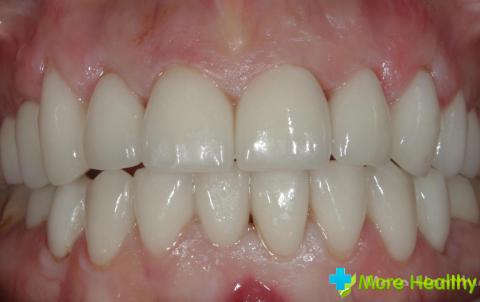
One of the most important functions in oral cavity perform chewing teeth. Therefore, if any pathologies develop in them, treatment should be started immediately. In case of damage to their integrity or loss of any element of the chewing group of teeth, it is necessary to restore this area as soon as possible. This will allow you not to interfere with the quality of chewing food. Also, crowns will stop the process of destruction of the bone tissue of the teeth and restore proper chewing.
Removable dentures as a method of prosthetics for chewing teeth
One of the most common types of prosthetics for the group of chewing teeth is removable. They contribute not only to the full restoration of the functionality of the dentition, but also provide an aesthetically pleasing smile, especially in cases where permanent prosthetics are not possible.
Modern dental technologies make it possible to produce structures that are very convenient and practical to use and are highly aesthetic.
There are several types of these prostheses:
- Clasp
- Nylon
- Acrylic
- Sectors
- Immediate dentures
The main indications for the use of removable crowns on chewing teeth:
- Complete absence of chewing teeth.
- Unstable condition of the teeth, which was formed as a result of the development of periodontal disease.
- If it is impossible to install implants.
- For temporary use in the manufacture of permanent crowns.

The wide popularity of this product can be explained by the following advantages:
- Simplicity and ease of use.
- Aesthetic appearance.
- Uniform load distribution throughout the structure.
- Reliable fixation.
- No need to grind down healthy teeth.
- Possibility of removal if necessary.
- Neutralizes dental deformation.
- Duration of use.
- All parts of the prosthesis responsible for fastening are neatly hidden and not visible.
- Availability and low cost of this service.
- Easy to care for, allows you to monitor the sanitary condition of the structure and, accordingly, oral hygiene.
The only drawback of this type of prosthetics for chewing teeth is the adaptation period after their installation. In most cases, there is a violation of diction, and a feeling of discomfort when chewing food, especially hard in consistency.
But this problem is eliminated immediately after several days of training and getting used to their location in the oral cavity. To get used to it as quickly as possible, experts recommend reading books out loud to improve diction, and learning to chew food should start with soft foods and bite off in small pieces.
Also an important factor is psychological adaptation to the presence of a removable denture in the mouth. The feeling that you have beautiful teeth and there is the possibility of properly chewing food with the help of chewing teeth, which will allow you to quickly learn how to use them.
- The structure consists of a base and made teeth. It is fixed using clasps to the supporting teeth. This is a modern dental lock that provides a strong hold without damaging tooth enamel. The only drawback is the visibility of this type of fastening when smiling and opening the mouth wide. There is also a method of attachment by suctioning the structure to the hard palate.
Modern dentistry provides many options for prosthetics of chewing teeth. Understanding their functional purpose and taking care of your health, if you experience the slightest ailment, we recommend not delaying your visit. dental clinic to resolve all problems.
Metal-ceramics as the best type of crowns for chewing teeth
The wide popularity of metal-ceramic crowns is due to their high strength, uncompetitive aesthetics and affordable cost.
Advantages of this type of crown:
- The material has increased strength.
- The technology for creating an orthodontic onlay made of metal-ceramics allows its appearance to resemble the natural bone tissue of teeth
- It is not colored by food dyes found in food products.
- The absence of toxic substances ensures complete safety of this type of product.
- Long service life.
The process of installing this design begins with diagnosing the condition of the teeth in the client’s oral cavity. Further, if the development of pathological processes in the oral cavity, teeth and gums is established, the necessary course of therapy is carried out. The next stage is tooth depulpation.
Metallo ceramic crown is fixed to the tooth with a ledge, which is formed when grinding the bone tissue of the tooth. This is done in order to prevent contact of the periodontium with the frame of the crown, made of metal. This technology helps prevent bleeding, the development of an allergic reaction, irritation and fluid accumulation in soft tissues.
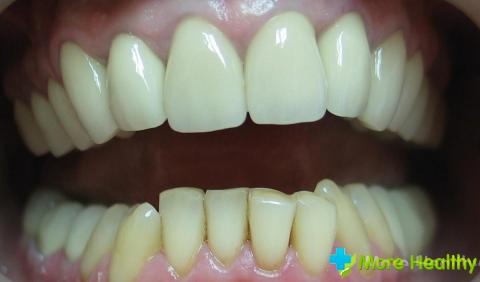
Next, an impression is taken from the stump, from which a metal-ceramic crown is made within 10-15 days. To protect the prepared tooth from an aggressive acidic environment. located in the oral cavity, the patient is given a temporary plastic crown.
After making a metal-ceramic crown, the patient first has the crown installed with temporary cement. If no problems arise during the wearing period, the crowns are fixed with special cement for permanent wearing of the crown.
After installing crowns, it is recommended to visit dental clinics every six months for preventive examination. This will keep your smile beautiful and healthy. long term. Regular monitoring of the condition of the teeth under the crown will allow timely detection of the development of pathological processes in them and will allow treatment to be carried out without removing the structures.
Also, due to the fact that most dental clinics provide a guarantee for a period of 1 to 3 years, if necessary, all treatment and repeated or reconstruction of already installed structures will be carried out free of charge.
Period of operation and cost of installing orthodontic onlays
With proper care and careful attitude to dental crowns, you can significantly extend their service life. There are reasons why structures can be dismantled:
- Not professionally made.
- Poor preparation for prosthetics.
- Expiration of the structure's service life.
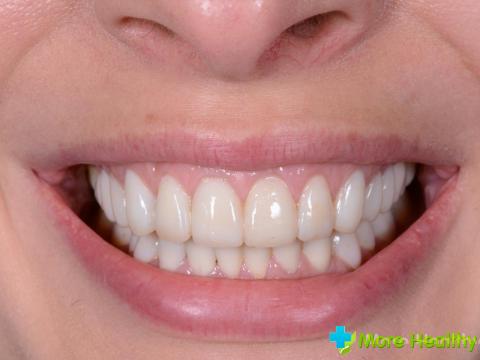
If prosthetics were performed correctly in dentistry, then the average time for using crowns, depending on the material, is:
- Metal ceramics - 12 years
- cast ceramics - 15 years
- zirconium dioxide - 15 years.
- Porcelain - 10 years.
- Gold or medical steel - 15 years.
- Solid plastic - 6 years.
- Metal-plastic - maximum term 10 years.
But it is worth understanding that the period of operation is determined by the quality of the material, compliance with all stages of manufacturing the orthodontic onlay and correct adjustment in accordance with the size of the teeth.
A wide range of these dental products allows you to choose the most cost-effective design.
Average cost:
- Metal-ceramics on a frame made of foreign metals costs over 8,000 rubles, and on a domestic one - from 4,000.
- If the frame is based on precious metals - from 9,000 to 20,000 rubles.
- Metal crowns start at 700 rubles.

But in any case, you cannot save on health. It is recommended to contact certified clinics that value their clients and provide them with only high-quality services.
It is impossible to overestimate the functional purpose of chewing teeth. If they are missing or there is pathological abrasion of bone tissue, the installation of orthodontic onlays that protect against further tooth decay will help. They ensure the restoration of chewing functions, improve a person’s quality of life and ennoble his appearance, providing the opportunity to lead a fulfilling lifestyle.
While watching the video, you can learn about the procedure for installing crowns.
A professional approach to the selection and installation of chewing teeth will ensure a long period of their use and a beautiful smile.
Many people know what a crown on a tooth is. In simple words, it is a kind of cap that is put on a tooth restored after destruction. A crown allows you to preserve the results of the treatment and extend the life of the tooth. In shape, it resembles an anatomically correct analogue of a real tooth, with its inherent relief and size. Since the crown is fixed to a cement base, it is a permanent prosthesis. In order to protect against the risk of repeated destruction, crowns are installed on the front teeth and in the lateral areas of the jaws. With proper prosthetics and the correct choice of material, the crown is no different from natural teeth and fully performs their functionality. To install a bridge, the lateral crowns of the structure are attached to the supporting teeth, which can be machined row elements and implants.
Indications and contraindications for installing a crown on a tooth
The feasibility of installing a crown on a tooth is determined by the dentist. In some cases, the doctor prefers an inlay or onlay instead of a filling to guarantee a more reliable and long-lasting result when using the prosthesis. Indications for its use are:
- significant destruction of the supragingival part of the natural tooth;
- excessive abrasion of enamel and hard tissues (bruxism);
- completion of the formation of the upper part of the artificial root - implant;
- restoration of an aesthetically attractive smile.
 Photos taken in the doctor’s office after the procedure show what a crown on a tooth looks like. These frames can be found on the website of the dental clinic when viewing the information of interest. The doctor may refuse to use a crown for the following reasons:
Photos taken in the doctor’s office after the procedure show what a crown on a tooth looks like. These frames can be found on the website of the dental clinic when viewing the information of interest. The doctor may refuse to use a crown for the following reasons:
- lack of protruding part of the tooth surface above the gum, insufficient height, severe destruction of the walls;
- looseness of a row element, in which the prosthesis is not able to stabilize the tooth in the jaw.
- allergic reactions of the patient to the material used in the manufacture of crowns.
- inharmonious bite, acute diseases periodontal tissues.
Factors that prevent the installation of a crown on a tooth include: childhood– up to 16 years of age.
Attractiveness and disadvantages of the design
With the help of a crown, you can extend the life of a natural tooth by recreating its structure and strengthening it with a kind of frame. Much depends on what kind of crowns you install on your teeth. Modern dentistry produces prostheses that are completely similar to natural teeth in shape, color, and light reflection. They look aesthetically pleasing, durable in use, and durable. If you have a crown installed on your tooth, the price may vary. It all depends on the base of the prosthesis - plastic, ceramics, metal, metal ceramics, zirconium dioxide.
The plastic product is temporary and is used for the period of manufacture of the permanent one. The metal stands out against the background of the dentition, so its installation in the frontal area of the smile is undesirable. The rest are similar to natural teeth. Metal ceramics are more accessible, zirconium dioxide is more expensive. Ceramic (porcelain) models are ideal for front teeth, but are cheaper than zirconium ones. In all situations, putting a crown on a tooth means prolonging its functionality. There are not many disadvantages to using a prosthesis. These include the necessary grinding of a natural tooth and possible depulpation.
The cost of installing various types of crowns on teeth in our dentistry
| Crowns and bridges: | |
| Solid metal crown (cobalt-chrome alloy) | 6000 rub. |
| Metal-ceramic crown (Ducera) | 7500 rub. |
| Metal-ceramic crown (Ivoclar) | 9500 rub. |
| Metal-ceramic crown (Ivoclar) with shoulder mass | 11500 rub. |
| Metal-ceramic crown (gold-containing alloy) | 27,000 rub. |
| Metal-free crown on a zirconium dioxide frame | 28,000 rub. |
| Metal-ceramic crown on an implant | 28,000 rub. |
| Metal-free crown on a zirconium dioxide frame for an implant | 44,000 rub. |
| Ceramic crown “Empress” | 16,000 rub. |
| Ceramic crown “IPS e.max Press” | 18,000 rub. |
Crown on a tooth - etiology of types of prosthesis
The division into types occurs according to the materials used in production. It is customary to highlight:
- Metal-ceramic crown on a tooth– the internal frame is made of metal, lined with ceramics on the outside. Has a good appearance, has increased strength. However, over time, the gums settle, exposing the visible edge of the metal band. Because of this, it is better to place metal ceramics in the lateral areas of the jaw.
- Ceramics (porcelain) is an aesthetically attractive prosthesis suitable for decorating front teeth. It is better not to use for chewing, as the material is fragile. Loads on it can become destructive, which will significantly reduce the service life of the prosthesis.
- Metal - available in several formats: solid, stamped, gold. They are good because they do not require thorough grinding of the tooth, however, to preserve the aesthetics of the smile, it is better to install a metal crown on elements that are removed in a row.
Among existing species There are also crowns for implants. They cover the abutment fixed to the base of the artificial titanium root.
Teeth crowns – which ones are better to choose?
It is difficult to unequivocally answer the question of which crowns are best to install on teeth. Much depends on the specific clinical case, the wishes of the patient and the budget available for these purposes. Metal crowns, provided they are not made of precious metals They are cheaper, but in terms of aesthetics they are inferior to their analogues. Metal-ceramics can be installed on teeth with preserved nerves, and since over time the metal edge of the internal frame in the gum area becomes visible, these crowns need to be placed on chewing teeth. They cope well with heavy loads, as they have increased wear resistance. Ceramics have ideal biocompatibility with oral tissues, which makes this dental crown optimal. However, a ceramic tooth crown has a certain fragility, and therefore is not advisable for installation in the lateral chewing areas. In terms of price, porcelain is the most expensive of the above options.
How a prosthesis is made - the subtleties of technology
Before a crown is installed on a tooth, the doctor performs a complete sanitation of the oral cavity. Impressions are taken from the jaws to match the crown as closely as possible with the tooth itself and its nearby neighbors. Features of the relief are taken into account in the manufacture of the prosthesis. The data obtained from the impressions is sent to the technician in the laboratory, indicating what types of dental crowns are needed. First, the specialist casts a plaster model, on the basis of which a semblance of a future crown is lined with wax. While the process of producing a permanent crown on the teeth is underway, the doctor masks the patient’s missing row with a temporary plastic-based structure. If we are talking about metal-ceramic prostheses, the metal frame is first cast, and then it is lined with ceramics along the upper field.
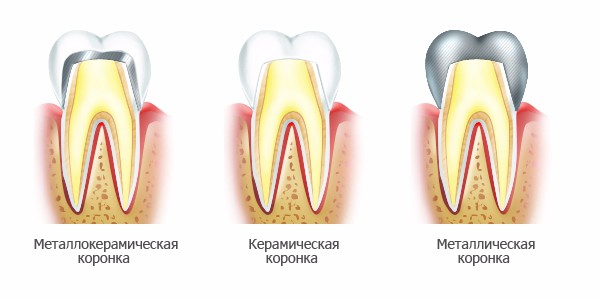
Crowns on teeth - reviews about installation
On the Internet you can find any information you are interested in, including about installation crowns on teeth - reviews patients who have undergone the procedure are a good help in setting their own expectations. The doctor performs the procedure according to the classical scheme:
- visual examination of the oral cavity, examination of the tooth for a crown, referral of the patient for an x-ray examination.
- If necessary, depulpation, removal of nerves, cleaning, therapy and canal filling are carried out.
- an anesthetic injection with an individually selected drug blocks pain symptoms, so tooth preparation is painless for the patient.
- If there is significant damage, an inlay is installed into the formed cavity, replacing the filling, after which it is closed with a crown. If necessary, the doctor can use a specialized pin that is inserted into the root of the tooth.
- After taking impressions, a crown is made for the chewing tooth or its anterior analogue. The choice of prosthesis material largely depends on its location.
After receiving the crown, the doctor tries it on. On the Internet you can find what a crown looks like on front tooth in the photo when the doctor demonstrates the result to the patient. The prosthesis is fixed using a special cement composition, which securely fastens it to the base of the tooth.
What is the difference between a crown and a filling?
When viewing the clinic’s portfolio on the website, where a tooth crown is presented before and after photos, one notices its perfection. It allows the tooth to look natural. The same effect can be achieved using a filling. However, composites are not so durable, and in the presence of a large cavity they cover, they are completely subject to an accelerated life cycle. In addition, the crown is not pigmented, while the most modern filling darkens after a few years under the influence of food coloring.
Photos before and after installing crowns on teeth

How long does a crown last, how to care for it
The prosthesis does not require specialized care. Just careful normal hygiene and professional cleaning twice a year in the doctor's office. Service life varies. For metal ones it is up to 25 years, metal-ceramic - up to 12, porcelain - up to 10. Sometimes the crown is removed due to inflammation of the root underneath it. This is often the result poor quality treatment, preceding prosthetics.
When choosing a clinic to visit, pay attention to the choice of a specialist who will perform prosthetics. This will help reduce the risks of poor-quality tooth treatment and will become a guarantee professional treatment and prosthetics. In dentistry "Dental S" services are provided professional doctors with extensive work experience. We use only high-quality materials, the latest equipment and medications. To find out the cost of the upcoming procedure, make an appointment with a doctor, consult with him about prosthetics, ask him to outline the advantages of the technologies and their differences from each other.
The question of which crowns are best to install will be decided depending on the group of teeth and your financial capabilities. In this article we will try to talk about the disadvantages and advantages of each type of crown, and which crowns are best to place in individual clinical cases.
Crowns for front teeth
Crowns for the front teeth must have good aesthetic qualities. These options include metal-ceramic crowns and metal-free ceramic crowns. Metal-free structures can be based on porcelain or zirconium dioxide.
Metal ceramics are the most commonly used material for prosthetics of the anterior group of teeth. It has an optimal price-quality ratio (it has fairly good aesthetic properties at an adequate price).
Crowns for chewing teeth
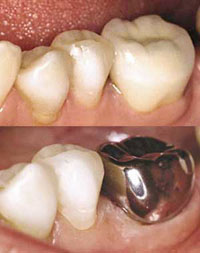
There are several options for prosthetics of the chewing teeth:
- metal cast crowns – in order to save money, crowns for chewing teeth can be made metal (they do not fall into the smile zone). Such crowns have a long service life (10-12 years), and also require less grinding of teeth compared to metal-ceramics;
- Metal-ceramics are crowns that have a metal frame and are lined with ceramic mass on top. They have optimal aesthetic properties and a fairly long service life;
- crowns made of metal-free ceramics - this option is the best and most expensive. We will talk in detail about the advantages of this material a little later;
- combined bridges - such structures can be installed if you need proper aesthetics, but want to save a little where you can do without it. For example, you need to make a bridge from the fifth to the seventh tooth. In this case, it is not necessary to veneer all three crowns with ceramic; you can veneer only those teeth that will be visible when you smile. The uncoated parts of the product will look like polished metal.
- In this way, you can save from 2500-3000 rubles (when replacing one metal-ceramic unit with a metal one).

Alternative to dental crowns
In addition to crowns, there are several options to choose from - restorations with composite materials, veneers and implants.
Veneers or crowns: pros and cons
When using crown prosthetics, teeth often have to be ground down to a significant thickness (2-2.5 mm), and they also need to be depulped. If you make a restoration using veneers, you only need to grind down the tooth by 1 mm, and then only from the front surface; there is no need to depulp the teeth. But veneers are only done on the front 10 upper teeth and on the 8 lower ones. Most often, they are placed if you are not satisfied with the color of your natural teeth, you have tremata and diastemas between the teeth (gaps)
Implant or crown: pros and cons
Implantation as an alternative to crowns is possible if you are missing one or several teeth in a row (that is, as a replacement for a bridge). Implantation is also a good option, if you have end defects. If the teeth at the edges of the defect are not pulpless, then, of course, it is better to place an implant so as not to kill adjacent teeth. If the neighboring teeth have large fillings or are pulpless, then it is better to replace the defect with a bridge.
In any case, when planning implantation, the implant surgeon must assess the conditions in the oral cavity (is there enough bone tissue, are there any important anatomical formations which can be damaged during implantation).
Filling or crown, pin or crown: pros and cons
Sometimes it is possible to restore the lost crown part of a tooth using filling material. Here you need to be guided by the following rule: if the crown is destroyed by more than half, you need prosthetics with a crown, but if less, it is possible to use a composite material. Restorations deteriorate very quickly. After only 3-5 years, they can collapse, change their color, and become dull. There may be a risk of tooth root fracture if the restoration breaks off, and such teeth must be removed.

When using crown prosthetics, if the coronal part of the tooth is significantly damaged, a pin is inserted into the tooth canal, which will serve as the foundation for the future crown. More often, instead of pins, cast stump inlays are made.
Ceramic or metal-ceramic crowns
Advantages of metal-ceramic crowns:
- acceptable aesthetics;
- long service life (9-10 years);
- this option is a compromise between metal crowns and metal-free ceramics.
Disadvantages of metal ceramics:
- it is necessary to remove a sufficiently large volume of hard tooth tissue for processing under a metal-ceramic structure;
- you need to depulpate your teeth (remove the nerves from them);
- the appearance of cyanosis of the gingival margin is possible - due to the fact that the crowns have a metal base, it may become translucent, which will be visible on the gums with a wide smile;
- it is possible that the crown will differ from the neighboring teeth. due to the presence in metal-ceramic crowns metal frame, the enamel on the crowns will not have the translucency inherent in natural teeth. As a result, crowns may be somewhat noticeable against the background of their teeth. this flaw will be especially important on the frontal group of teeth - the light will fall on the dentition, emphasizing the translucency natural teeth and lack of transparency in crowns.
If you need to replace all central teeth at once, then all crowns will have the same level of translucency, and this metal-ceramic defect will not be noticeable. There are two types of metal-free ceramics: porcelain and zirconium dioxide.

- Porcelain crowns are used only to replace one tooth; porcelain bridges are not made because of its fragility.
- Zirconium dioxide is the hardest and most reliable material available today. Its strength is the same as that of metal, but at the same time it has excellent aesthetic properties.
Advantages of metal-free ceramics:
- the best aesthetics, fully conveying natural properties human teeth. It is very difficult to distinguish such crowns from your own teeth. This is due to similar optical properties to natural enamel;
- the aesthetic properties of ceramics do not change over time; we can safely say that the crown will not turn yellow, will not fade or lose its shine.
What is the purpose of correcting a bite with crowns?
Crowns can indeed correct misaligned teeth. But at the same time, it is necessary to remove a large amount of hard tooth tissue, depulpate it, and therefore make it more fragile. As an alternative, we can offer bite correction with veneers. They can also eliminate diastemas and gaps between teeth, improve their color and shape, but will not require as much grinding of the teeth. You can also use various orthodontic devices, such as plates and braces, to correct your bite. This is the only way to eliminate significant defects in the position of teeth in the dental arch.
Crown care
If you have single crowns in your mouth, then you need to use a toothbrush, floss and brush to clean them. Difficulties arise if you have bridges. It is very difficult to clean in the area of their intermediate part (between artificial tooth and gum). For this purpose, irrigators were invented - these are devices that create a pulsating under pressure stream of water with air, capable of knocking out food debris from narrow and hard-to-reach places.
How long will dental crowns cost?
The service life of any crowns is about 10 years. But there is a small question. The service life will depend on how the tooth was prepared for prosthetics. If the channels are sealed poorly, it may appear inflammatory process at the root of the tooth. And then you will either have to remove the tooth, or remove the crown and re-treat the canal.
Cost of crowns
- The price of a metal cast crown is 3000-4000 rubles.
- The price of a crown for a tooth made of metal-ceramics is 6000-7000 rubles.
- The price of a zirconium dioxide crown starts from 15,000 rubles.
Do not forget that in order to protect the treated dental tissues and also restore aesthetic properties at the stages of prosthetics, plastic crowns are needed. The price per unit is about 1000 rubles.
Dental crowns: reviews
If all clinical (teeth are properly ground, impressions are taken, etc.) and laboratory stages (quality materials, all rules for making crowns are followed) were performed correctly, reviews of crowns will always be good, they will serve for a long time and with high quality.








